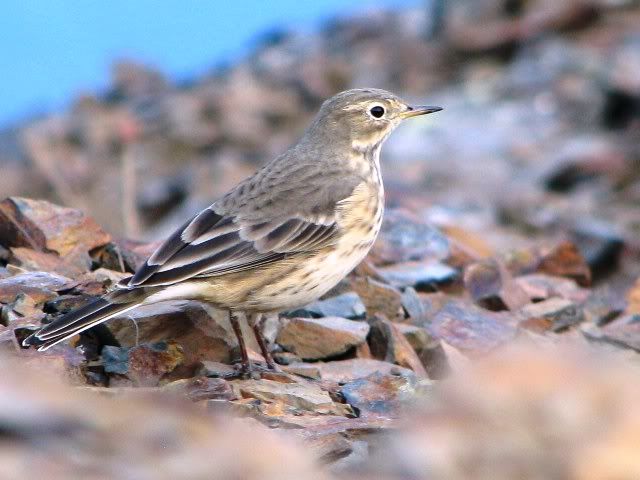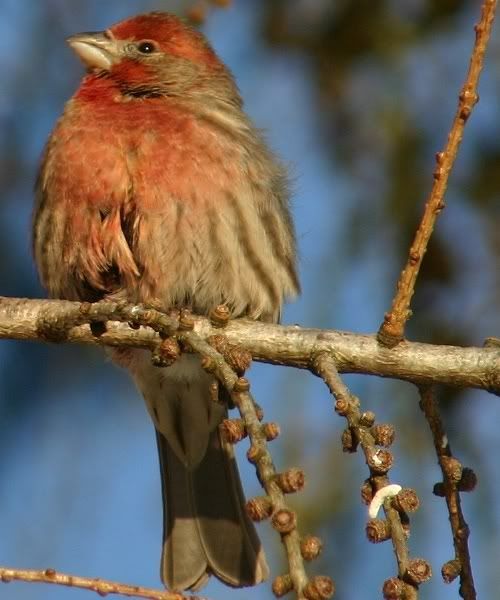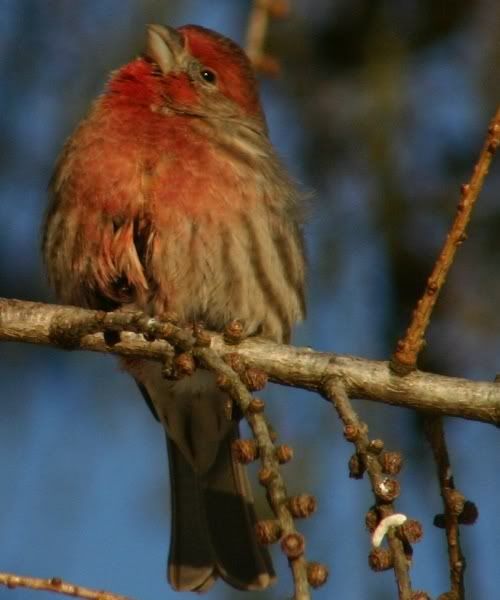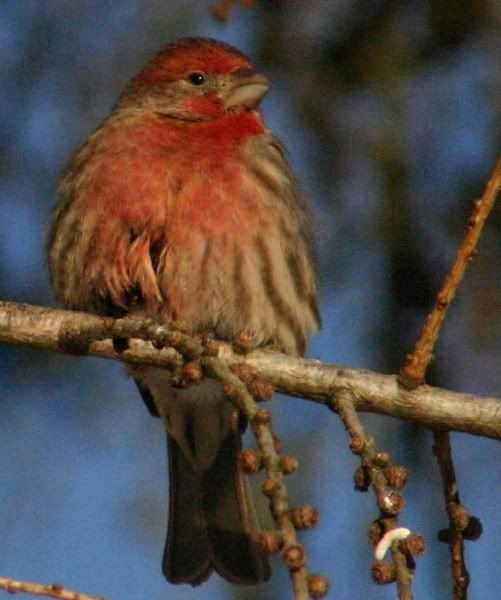|
|
Post by tmanson on Oct 27, 2006 17:03:44 GMT -8
Fellow birders: Earlier Jeff was inquiring about whether to buy a scope or a good birding camera/lens. I don't know if he eventually decided between the two?
There has been an interesting thread on Tweeteres this past week on what is the optimal camera/lens set up for birding; ( within a budget ).
The original poster seems like she has decided on a Canon camera with a 400 mm lens. This, despite the fac,t that the majority of posters recommended a 100-400mm zoom lens.
We have some great photographers on this site; Gord, Dave, Kathy, Brent, and I am wondering what they would recommend?
This would not have to be a hard recommendation for me, as it looks like my wife has decided that we will be spending our discretionary spending on a 2 month trip to Cuba this winter; ( oh well, they have 20 plus endemic species there, plus all those wintering neoptropicals! ).
On the cheaper end of the scale, one birder recommended the Panasonic Lumix FZ50 digitial camera with 10 megapixel, and a 12x optical zoom. It seemed to me like this was an interesting compromise; not an SLR, but a camera with that can zoom to 400mm, not too heavy, but with an image stabilizer, and an automatic focus. Its price, at least in American dollars, seemed to be at least half of the other, cameras/lenses that were recommended.
I'm not happy with myself, in last year, buying a cheap digital camera, and then trying to adapt it to my scope, so I would be interested in hearing about other options. Cheers, Thor
Thor Manson
Hope, B.C.
|
|
|
|
Post by Gord on Oct 28, 2006 22:01:20 GMT -8
Sounds like the compromise idea might be the way to go. I like SLR cameras and if money wasnt an object, Id say that is the way to go even though the sky's the limit on how much you can spend. Which sometimes begs the question why have one if the ability to buy the lenses (necessary to get the most from it) is limited. I use a 100mm - 300mm lens on the digital SLR, and on the film SLR, a 70mm-210mm with a 2.0x teleconverter. All lenses are 'slow' (need low shutter speeds unless light is perfect) and do not produce very sharp images. I just smile and do what I can and dream of getting a lens that is a little sharper and 'faster'. No point in missing out on the stuff I can shoot today because I could/maybe have something better later/someday/never. That being said, if there's a limit on cost and that applies to most of us, the camera like the Panasonic FZ50 is certainly worthwhile. Smaller and more compact for travel which is a bonus even for around home. Kathy has a similar camera and the results cannot be argued with at all. A guy at work has one and has taken great shots with it as well. I have also used similar cameras to check them out and while getting used to operating it, I can see it is not a bad choice and is certainly better than trying to get shots of birds with a compact camera. Those are only really good for adapting to the scope for digiscoping or taking scenic shots. Today with limited funds, if I were in the market for a camera, I would probably settle for one like you are considering, Thor. Look forward to seeing some good pictures from Cuba! You lucky!!  |
|
|
|
Post by tmanson on Oct 29, 2006 10:25:18 GMT -8
Gord: Thanks for your thoughtful response. Any other photographers with recommendations? Dave, I know you're busy 7 days a week these days, but?. Kathy, I think is out of commission for awhile, and I have spoken to Brent about photography on a number of occasions.
Any other photographers out there that would like to share an opinion on this subject. Thanks. Thor
Thor Manson
Hope, B.C.
|
|
|
|
Post by Dave on Oct 30, 2006 13:00:09 GMT -8
Thor,
I have a Canon Power Shot S2 IS, image stabilizer, 5.0 megapixels, 12x optical zoom camera. $500.00
The results are in previous postings. I like the camera, considering is was quite cheap and does a very good job on most birds.
One day when I am a rich and famous globe-trodder who has to "settle" on going to Cuba, I will buy an SLR and goodies!
(sorry about not doing much birding lately!)
DB
|
|
|
|
Post by Dave on Oct 30, 2006 17:46:27 GMT -8
More comments, I also find the 12x zoom is enough for most bird pictures at a sensible range. That 10 megapixels/12x Optical zoom sounds great, as far as "cheap" cameras are concerned. Sometimes autofocus automatically focuses on the wrong thing, and flybys do not work, but for the stationary bird, it does well. It is a fast camera, so the split second the kinglet or warbler stops, it will get a nice shot. You can also set it to take 10 frames in about 2 seconds or so, and then go through the 10 shots to see which one you like the best. I have used that with success on warblers. Again, it needs to focus on the bird first before you fire off 10 pictures focused on the leaf wiggling in front of it. Also, I don't change the pictures at all with colour or whatever fancy computer stuff is available. What you see is what I took in the field. One day I will take the time to learn how to spruce up pictures with all the fancy software available. Maybe if you know how to do this computer stuff, you can get even nicer pictures with a camera like the one you are looking at. Here are two of my favourite shots: Pipit on Cheam Ridge  Marsh Wren at Cheam Wetlands  |
|
|
|
Post by Ichthos on Oct 31, 2006 8:00:49 GMT -8
I have the Panasonic Lumix FZ-30. It is basically the same camera as the FZ-50, but has only 8 megapixels of resolution. Overall I am quite happy with it, but that's only because the price was right. The quality of the lens is great, but I find this camera needs a lot of light for great results. I find the biggest drawback is the small sensor size, and images at full crop are not up to par IMHO. This would lead me to expect that the increase to 10 megapixel resolution is probably not going to improve image quality. In order for me to upgrade I would have needed to see a bigger sensor in the FZ-50 instead of cramming even more pixels onto this small sensor. Here's some examples of what I mean from some shots I took yesterday. With the smaller sensor it is important to keep the shutter speed up in order to avoid 'purple fringing'as can be seen on the back of this trumpeter swan in the first pic. 100% crop at 1/320th shutter speed:  100% crop at 1/800th shutter speed:  Any high-contrast shots come out quite a bit darker than what you see because of the increased shutter speed. This can give you some rather nice results though, like this:  More often, though, I find myself somewhat frustrated when light conditions are not ideal. This is the best I could do with this Western Grebe in the shadows:  100% crop:  The grain in the picture is called 'noise'. Keeping the ISO setting low helps a lot to reduce this, and I take all my pictures at ISO 80. I suppose this is why I need a lot of light. When there is enough light I do get results that I am happy with:  I did quite a bit of research before I decided to buy this camera, and I believe it is one of the best non-DSLR cameras on the market. If you want better quality it will mean a DSLR body and some good quality lenses, which is going to cost you at least double the price of this camera. Cheers, George |
|
|
|
Post by Gord on Oct 31, 2006 17:22:29 GMT -8
Good info guys.
Nice pictures George and Dave to help show your stuff. I like that merganser on take-off! A uncommon picture to see.
Dave made a good comment on the auto-focus. It is nice to have the option for manual focus for the reasons Dave mentioned, but I dont think it's possible on any of these cameras.
Pros and cons on all options. $$$ Is always an important pro.
|
|
|
|
Post by tmanson on Oct 31, 2006 19:05:46 GMT -8
Gord/Dave/George: Wow, what a great, informative discussion. Thanks very much for the input. Gord, apparently, the Panasonic Lummix FZ50 allows for manual focus.
A point the Washington State poster made is that, with an Olympus 1.7 teleconverter, the focal length of this camera increases to 700 mm, without any loss of light. George, do you have any comments about that?
Also, I would be interested to know if any members have had experience buying a camera, using an on-line retailer. When I look up the price of a Panasonic Lummix FZ50, and type in best buy, I find prices as low as $500 U.S. ( approx ). This includes lens cap, and hood, strap, Lithium battery, and battery charger, a small memory card, and user manual. Compared to a popular Vancouver retailer, there is a over a $250 difference. The Canadian retailer will add tax, and does not seem to include any of the above extras. The American retailer will charge shipping. Who knows what the duty is? Also have to add 10% for exchage. The warranty also is an American warranty, and may not be valid in Canada.
Thanks for the continuing input. Cheers. Thor
Thor Manson
Hope, B.C.
|
|
|
|
Post by Gord on Oct 31, 2006 20:38:37 GMT -8
Thor, I have never bought online or out of the country before. I know a lot of people who do buy online including my brother and I havnt heard any horror stories yet. Im just nervous with the new technology, my credit cards, people's honesty and the huge amount of people who obviously have nothing better to do than create viruses and hack other people's computers.
If you do do any online buying, Id suggest having a mastercard/visa card with a very low limit on it for online or other 'risky' uses. If someone gets your number, they can only do $1000.00 (or what ever limit you set) damage. Be aware that some card companies up your limit as time goes on without letting you know. I just found mine was at a stupidly high amount. I will get them to lower it, and I believe you can also request that the limit remain the same (frozen) unless you request an increase.
Back to cameras, the FZ50 sounds even more promising with the manual focus option. The small sensor sounds like a bit of a drawback (like a slower SLR lens ie. f 4-5.6). I would only guess that a larger sensor would carry more cost just like a faster SLR lens would. A plus might be image stabilization since most shots are done sans tripod (although I try to shoot off a tripod as much as possible) to compensate for motion. How well does this work, George?
Looking at reviews for this camera (http://www.photoxels.com/panasonic-fz50.html) I see it talks about automatic ISO control. This might concern me if it isnt something you can turn off and on (Id expect you can) as once you hit ISO 200+, the image gets grainy. A lot of shots we birders take are in low light conditions and Id rather be able to choose between slower shutter speeds, shallower depth of field or higher ISO to compensate depending on the need.
Obviously Im scared of pretty well any automatic feature on a camera as I grew up with an ancient SLR where everything was manual. I do like that this model seems to have the option to adjust shutter and aperature quickly on the camera body and not through the camera. Again, my SLR bias showing through.
I like the sound of the 1.7 teleconverter and that it doesnt sound like it removes the 1.5 - 2 stops of light that most teleconverters seem to do. Im interested to hear more! Also you can change lenses on this camera?
Im liking the sounds of the camera myself.
|
|
|
|
Post by Ichthos on Nov 1, 2006 17:42:35 GMT -8
Yes, these cameras are fully manual if you so desire. You can also choose what you would like to have manual and what auto, like focus, ISO, shutter speed, etc. You can also create custom presets for your settings. I purchased the Olympus 1.7 extender with my camera, and I am quite pleased with it. There is a loss of several stops though, which is normal. The nice thing about this camera is that the image stabilization works very well, and I often take shots down to 1/20th of a second at full zoom and they come out quite nice. No, the lens on this camera can not be changed. However, you would be hard pressed to find a better lens to put on it. I think the same quality lens for a DSLR sized sensor would set you back at least $1500.00 To give you an idea of the difference in sensor size, the FZ-30 has a sensor size of 7.18 x 5.32 mm. The Canon Rebel XT has a sensor size of 22.2 x 14.8 mm. The Canon EOS-1D Mark II N has a sensor size of 28.7 x 19.1 mm. Of course, the 1D Mark II will set you back $4000.00  or more for the body alone, but the difference in quality is amazing. Check out the wood ducks here: www.pbase.com/danator/wood_duck_babySome of this fellows pictures almost seem fake, that's how good they are. A Roseate Spoonbill:  An excellent review site is dpreview. You can find the FZ-50 review here: www.dpreview.com/reviews/panasonicfz50/ |
|
|
|
Post by tmanson on Nov 2, 2006 20:19:16 GMT -8
Gord/Dave/George et al: Thanks again for your insights. Also thanks to Brent, who replied privately. I have learned quite a bit about digital photography, just reading your responses, and going to a vareity of suggested links.
In the end, like anything else, I guess you get what you pay for.
The Panasonic Lummix FZ50 is available from online American dealers for about $500. The cheapest I can find it for in Canada is $800, without some of the add ons that the American dealers provide.
I have to go into Vancouver tomorrow; ( Friday), and I will check out the local retailers.
I guess, in the end, I need to know, if it is possible to fully know, is there a better non-SLR digital camera, which has this camera's features at a better price? It is very clear to me, from your responses, that it would be better to go the SLR route, but I am definitely price sensitive.
Also, as my intentions were, when I tried digiscoping, I am not looking for the perfect picuture, as much as I am trying to provide easy to take records of birds I see, for my own satisfaction, as well as for asking the opinions of fellow birders on on id challenges. Therefore, having a fairly compact camera is important to me, especially if I am also packing my scope, and bins, when in the field. I know that is asking a lot out of one camera, but that is the challenge.
Any more opinions, keep them coming. Thanks again for your help. Cheers, Thor
Thor Manson
Hope, B.C.
|
|
|
|
Post by Dave on Nov 2, 2006 22:24:58 GMT -8
Thor,
I think that if you are using your camera casually for ID and to "share pictures on this website with us ;D", then $800 is plenty to spend. You do not need to double that...... There are times I wish I had a better camera, but that is usually when birds are moving so fast that I would need to spend $5000.00 to get the good picture. $800 will get you great pictures of gulls, woodpeckers, sparrows, ducks, etc. You will have a hard time getting that hawk flying by though, you'll have to wait for it to land!
As a prewarning, a $500.00 camera will end up costing $800 by the time you have the case, warranty, taxes, etc!
Dave
|
|
|
|
Post by tmanson on Nov 26, 2006 22:56:15 GMT -8
Hi Gord/Dave/George: Playing with my new camera, I referenced this thread to the owner's manual. This is about ISO's. The manual says, the higher the sensitivity is set, the less light is needed to take a picture, so the camera becomes more suitable for recording in dark places.
I remember George saying he takes all his pictures at ISO 80 to reduce noise. I think he also made the comment, that at this setting, he needs lots of light, but he also comments that taking pictures of birds often takes place is less than ideal lighting conditions. Is there then a tradeoff of less noise for darker images? My camera seems to have a manual ISO range of 100 to 1600. Any advice?
Thor, in snowed out Hope
Thor Manson
|
|
|
|
Post by Gord on Nov 27, 2006 21:01:19 GMT -8
Thor, you got the right idea.
When I shot film cameras, I used ISO 50 and 100 exclusively. Even ISO 200 started to show some grain.
In digital, I use the lowest ISO whenever I can (ISO 100). When I put it up higher, the grain starts to show up. Tomorrow, I will take some images with camera at 100 and then a higher ISO for comparison.
As George said, lower the ISO, the more light is needed. So if you're shooting in low light, you're going to need slower shutter speeds. This might result in non-crisp images due to camera shake. So, between a blurred image or slightly grainy one, Id go for the higher ISO, but still, anything above 200 is a bit ugly. I do not believe that the uses we need a camera for will never need ISO 1600 unless they have somehow improved things dramatically.
From what I know, I would not use the ability for high ISO in a camera to count for too much.
|
|
|
|
Post by Gord on Nov 28, 2006 21:01:43 GMT -8
Here are some pictures I took today to illustrate what I know about ISO (or ASA for film cameras). I did not use a tripod (simply because it's broken  ) but did use a little gimmick I created a while back and have not had time to share yet to help steady a camera. I made the images a bit larger than usual to show each different setting. Note how the shutter speed increases as the ISO goes up. I could have upped the aperature as well instead of just doing the shutter speed, but I was in a hurry as they were not sitting still long enough for me to use all 3 ISO speeds. House finch male at ISO 100 shutter speed 1/250 sec, aperature f/ 11  House finch male at ISO 400 shutter speed 1/800 sec, aperature f/ 11 (I goofed on the focus here  )  House finch male at ISO 1600 shutter speed 1/3200 sec, aperature f/ 11  The 400 ISO is acceptable for grainy images. ISO 200 would probably look good, and would also have given me more light over the 100 ISO to increase shutter speed which is very important when not using a tripod for photography. |
|